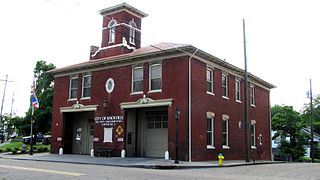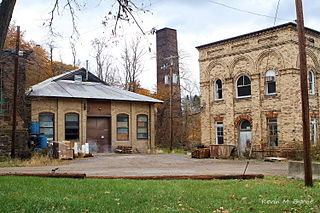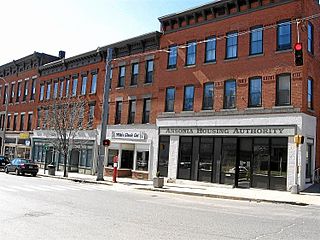
Cumberland is a city in and the county seat of Allegany County, Maryland, United States. At the 2020 census, the city had a population of 19,075. Located on the Potomac River, Cumberland is a regional business and commercial center for Western Maryland and the Potomac Highlands of West Virginia. It is the primary city of the Cumberland metropolitan area, which had 95,044 residents in 2020.

Mechanicsville is a neighborhood in Knoxville, Tennessee, United States, located northwest of the city's downtown area. One of the city's oldest neighborhoods, Mechanicsville was established in the late 1860s for skilled laborers working in the many factories that sprang up along Knoxville's periphery. The neighborhood still contains a significant number of late-19th-century Victorian homes, and a notable concentration of early-20th-century shotgun houses. In 1980, several dozen properties in Mechanicsville were added to the National Register of Historic Places as the Mechanicsville Historic District. The neighborhood was also designated as a local historic district in 1991, subject to historic zoning and design standards.

Union Square is a neighborhood located in the Sowebo area of Baltimore. It dates to the 1830s and includes a historic district of houses and commerce buildings.

Mount Savage is an unincorporated community and census-designated place (CDP) in Allegany County, Maryland, United States. As of the 2010 census it had a population of 873.

Glenville Historic District, also known as Sherwood's Bridge, is a 33.9 acres (13.7 ha) historic district in the Glenville neighborhood of the town of Greenwich, Connecticut. It is the "most comprehensive example of a New England mill village within the Town of Greenwich". It "is also historically significant as one of the town's major staging areas of immigrants, predominantly Irish in the 19th century and Polish in the 20th century" and remains "the primary settlement of Poles in the town". Further, "[t]he district is architecturally significant because it contains two elaborate examples of mill construction, designed in the Romanesque Revival and a transitional Stick-style/Queen Anne; an excellent example of a Georgian Revival school; and notable examples of domestic and commercial architecture, including a Queen Anne mansion and an Italianate store building."

George Truog House is a historic home in Cumberland, Allegany County, Maryland, United States. It is a 3-story brick structure built in 1903. The house was designed by local architect Wright Butler, and built by George Truog, proprietor of the Maryland Glass Etching Works in Cumberland from 1893 to 1911. It contains a unique collection of decorative glass.

Cumberland station is a historic railway station in Cumberland, Allegany County, Maryland. It was built in 1913 as a stop for the Western Maryland Railway (WM). The building was operated as a passenger station until the WM ended service in 1959, and it continued to be used by the railway until 1976. It was subsequently restored and currently serves as a museum and offices, as well as the operating base for a heritage railway.
The Frostburg Historic District is a national historic district in Frostburg, Allegany County, Maryland. It comprises 356 resources within the city of Frostburg, along U.S. Route 40, which forms the main axis of the district. Included are a collection of early-20th century commercial buildings, primarily of brick construction, two or three stories tall, and a collection of mid- to late-19th and early-20th century homes reflecting a variety of architectural styles, including Italianate, Second Empire, Queen Anne, and Colonial Revival.

The Greene Street Historic District is a national historic district in Cumberland, Allegany County, Maryland. It is a 7-acre (28,000 m2) linear historic district along both sides of Greene Street on the west side of Cumberland. It contains 45 buildings, 37 of which are residential and 8 of which exhibit commercial design characteristics. The earliest buildings in the district are built in the Federal style, followed by buildings erected in the Greek Revival, Italianate, Queen Anne, and Colonial Revival styles. The earliest of the district's resources was constructed about 1820, with the most recent built about 1930.

The Washington Street Historic District is a national historic district named after George Washington in Cumberland, Allegany County, Maryland. It is an approximately 35-acre (140,000 m2) residential area to the west of downtown Cumberland and consists primarily of six blocks of Washington Street. It contains large-scale 19th- and 20th-century houses representing most of the major architectural styles, including examples of Greek Revival, Italianate, Gothic, Queen Anne, Romanesque, Colonial Revival, and bungalow. Also included in the district are the 1890s Romanesque courthouse, the 1850s Greek Revival academy building, and the Algonquin Hotel. It was listed on the National Register of Historic Places in 1973.

The Mount Savage Historic District is a national historic district in Mount Savage, Allegany County, Maryland. It comprises 189 19th and 20th century buildings, structures, and sites within this industrial community northwest of Cumberland. The structures reflect the community's development as a center of the iron, coal, brick, and railroad industries from the 1830s to the early 20th century. Included are a set of vertical-board duplexes on Old Row built about 1840, and possibly the earliest examples of workers' housing remaining in the region.

The Inns on the National Road is a national historic district near Cumberland, Allegany County, Maryland. It originally consisted of 11 Maryland inns on the National Road and located in Allegany and Garrett counties. Those that remain stand as the physical remains of the almost-legendary hospitality offered on this well-traveled route to the west.

St. Leo's Church is a historic Roman Catholic church complex located within the Archdiocese of Baltimore in Little Italy, Baltimore, Maryland, United States. It is the 'core' of the neighborhood.

Rolling Mill Historic District is a national historic district located at Cumberland, Allegany County, Maryland. It is a 38-acre (15 ha) primarily residential historic district located on the east side of the city of Cumberland. It contains a strong, locally distinctive concentration of wood and brick residences built between the early 1870s and the late 1940s. It also includes a modest commercial area. The district has a total of 173 properties, including the previously listed Francis Haley House.

Klots Throwing Company Mill is a historic silk mill located at Cumberland in Allegany County, Maryland, United States. It was built in 1902–1903, and is a long two-story brick building with double-gable roofs and paired stepped parapets. An addition was built in 1909. It was operated by Gentex Corporation and closed in 1972. The building was subsequently used for storage. From 1988 until 2002, the north end of the building housed the Western Maryland Food Bank. The building will be converted to loft apartments.

The Rutland Courthouse Historic District encompasses an architecturally cohesive area of civic and residential buildings in Rutland, Vermont. Roughly bounded by Court, Washington, South Main, and West Streets, the district was principally developed between 1850 and 1875, and includes a number of prominent municipal and county buildings, including the Rutland County courthouse, the Rutland Free Library, and the Grace Congregational United Church. The district was listed on the National Register of Historic Places in 1976.

The Clara and Julius Schmidt House is a historic house in Wabasha, Minnesota, United States. It was built in 1888 in the Italianate style and features architectural details rendered in tin. The house was listed on the National Register of Historic Places in 1989 for its local significance in the theme of architecture. It was nominated for being a prominent example of the brick homes constructed by Wabasha's late-19th-century merchant class, one made particularly distinctive by its tinwork.

The Henry S. and Magdalena Schwedes House is a historic house in Wabasha, Minnesota, United States. It was built in 1882, part of a unique trend among the city's merchant class for brick houses. It was listed on the National Register of Historic Places in 1989 for its local significance in the theme of architecture. It was nominated for typifying Italianate architecture in its peak year of popularity in Wabasha, and for inaugurating a second generation of the town's merchants living in brick homes.

The Lucas Kuehn House is a historic house in Wabasha, Minnesota, United States. It was built in 1878 for Lucas Kuehn (1834–?), the city's leading merchant of the 19th century. The house was the city's first to be designed in the Italianate style. It was also part of a unique trend among Wabasha's merchant class for houses constructed of brick. It was listed on the National Register of Historic Places in 1994 for its local significance in the themes of architecture and commerce. It was nominated for its associations with Kuehn and for its exemplary Italianate architecture.

The Upper Main Street Historic District encompasses a collection of mainly late-19th-century commercial buildings on Main Street in downtown Ansonia, Connecticut. Extending south from Maple Street, the district exemplifies the rapid commercial growth of the city at that time. Its most prominent feature is the Ansonia Opera House, built 1870. The district was listed on the National Register of Historic Places in 1982.























